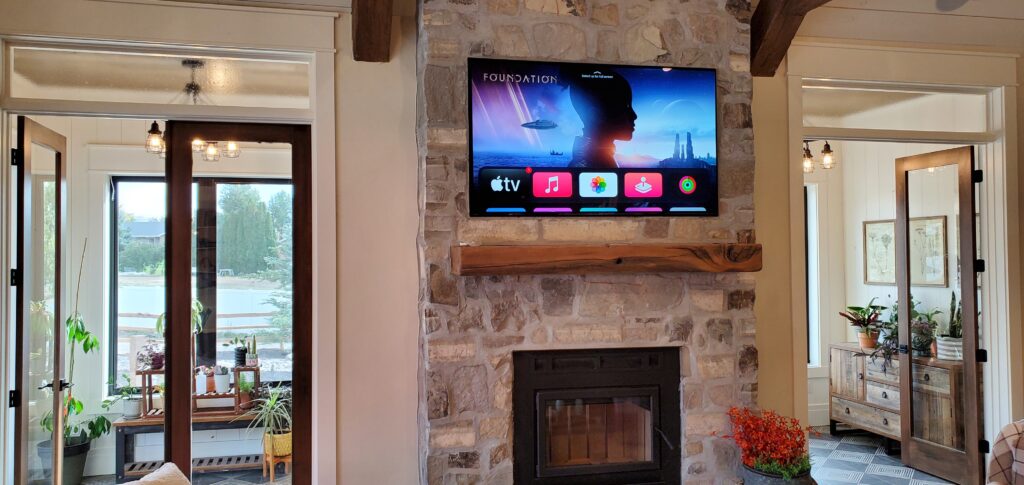One of the most popular questions among people who love to watch movies or TV shows from their home theater system is, “Can I stream surround sound?” With so many streaming services available today, it can be difficult to find out which ones offer this capability. However, there are many benefits of streaming in surround sound, and it’s definitely worth looking into if you’re not currently doing so.
From a powerful, immersive sound experience to a wide variety of programming options, streaming in surround can lead to a better overall home theater experience. In this article, we’ll explore Netflix and four other streaming services to see which of them offer streaming surround sound capability.
Can you stream movies in surround sound?
Surround sound has been a staple of movie theaters for many years, and more recently it has become popular in home theater systems as well. This technology creates a realistic audio experience that can make you feel like you’re right in the middle of the action on the screen.
To get surround sound from a streaming app, it must travel through your smart TV or streaming device and then to your sound system.
Streaming Service / App vs. Streaming Device
When setting up your home theater, it’s important to understand the difference between a streaming device and a streaming service, as the two work together but serve very different roles.
A streaming device is a piece of hardware that connects to your television and allows you to access digital content over the internet. Examples include popular options like Apple TV, Roku, Amazon Fire TV, and Google Chromecast. These devices act as the gateway between your TV and various apps, offering an easy way to navigate, browse, and play streaming content on a large screen.
On the other hand, a streaming service is a digital platform (essentially an app or subscription service) where you can access movies, TV shows, and other media. Examples include Netflix, Hulu, Disney+, and Amazon Prime Video. Streaming services host the content, but you typically need a compatible streaming device (or a smart TV with built-in apps) to access them conveniently on your television.
- Apple TV
- Roku
- Amazon Fire TV
- Chromecast
Streaming devices differ from a streaming service, like Hulu, in that streaming devices usually offer more channels and options than streaming services.
Streaming services are designed to work specifically with a streaming device.
Decoding and Encoding Surround Sound
However, most streaming devices do not decode surround sound and instead transcode encoded surround sound signals into a format that can be decoded by a TV, soundbar, home theater receiver, or other external audio systems.
Smart TVs with built-in applications can also transmit encoded surround sound signals to an external audio system, and most of them support various surround sound codecs. However, be aware that the manufacturer may at any time upgrade the device’s support for surround sound formats.
Audio Passthrough
To enjoy streaming surround sound from your favorite services, you’ll need a streaming device with audio passthrough. Audio passthrough is the ability of a smart TV or set-top box to pass encoded surround sound signals directly through it and into an external speaker system.
How do I know if my TV has audio passthrough?
If you’re not sure whether your TV has audio passthrough, there are a few ways to find out.
- Check the specifications: This is the easiest way to determine if your TV has audio passthrough. All the latest TVs will include this information in their technical specifications.
- Check the input: Another way to check is by looking at the inputs on your TV. If you see an optical audio port, it’s likely that your TV has audio passthrough.
- Try it out: You can also try streaming a movie or show in surround sound and see if your TV passes the signal through to your external speakers.
If you have a newer TV and it doesn’t pass the signal through, check with your manufacturer to see if there’s an update available.
What Streaming Services Offer Surround Sound?
There are many streaming services that offer movies or shows in surround sound. Some of these apps may be built into your smart TV while others require installation on a streaming device. Each streaming service offers different types of surround sound compatibility, including 5.1, 7.1, and Dolby Atmos, which adds audio that comes from above you, rather than in front of or behind you.
Netflix
Netflix is one of the most popular and well-known apps for watching movies or TV shows from your home theater system. This app offers a huge library of on-demand programming, with thousands of titles in surround sound or compatible with devices or smart TVs.
Netflix offers a 2.1 stereo audio setting by default, although if you have a compatible device, it switches to surround sound automatically.
Beginning in 2017, some Netflix films feature a surround sound audio experience thanks to the Dolby Atmos technology integration. This allows people to listen at 5.1, 7.1 or higher-quality audio.
How do I know which titles are available in high-quality audio?
All titles supporting 5.1 surround or Dolby Atmos have high-quality sound. A Dolby Digital Plus icon or a 5.1 symbol will appear next to the description of any title with 5.1 surround sound if it is available. If a title has Dolby Atmos, a Dolby Atmos icon will display next to the description.
What do I need to stream with 5.1 surround sound?
- A 5.1 surround sound-ready audio system
- A Netflix-capable device with 5.1 surround sound support.
- Set your streaming quality to Medium, High, or Auto.
Netflix Help Article: 5.1 Surround Sound on Neflix
Hulu
Like Netflix, Hulu offers a vast selection of movies and TV shows in surround sound to compatible devices or smart TVs.
Hulu’s streaming library and Live TV programming stream audio in 2.0 stereo quality by default, but certain live content and on-demand titles may be viewed in high definition 5.1 surround sound on select devices. During live play or on the title’s Details page, badges may indicate when 5.1 is accessible.
Keep the following things in mind setting up 5.1 surround sound:
If you want surround sound on compatible devices, you’ll need to select a 5.1-compatible option from the audio output menu.
When using HDMI to output audio, 5.1 PCM or bitstream audio must be enabled.
If your device has optical or coaxial connections for outputting audio, you’ll almost certainly need to enable Dolby Digital Plus or DTS bitstream.
Amazon Prime
Like Netflix and Hulu, Amazon Prime Video offers a library of movies and TV shows that can stream in surround sound to compatible devices or smart TVs.
Prime Video offers audio in stereo by default, but some titles offer Dolby Digital Plus or Dolby Atmos audio. You can identify Prime Video titles with surround sound by looking for the Dolby Digital Plus (Surround) or Dolby Atmos logo next to the title.
To enjoy Prime Video content in surround sound on a compatible device, you must have a device that supports Dolby Digital Plus or Dolby Atmos.
Additionally, if you’re using an HDMI connection to your TV, make sure “HDMI Audio” is set to “Bitstream.”
If you are not getting surround sound from Prime Video on your device, try the following:
- Check that your device is on the correct input;
- Check that your device is outputting audio in Dolby Digital or DTS format;
- Try a different HDMI cable;
Disney+
Disney+ subscribers can enjoy a vast library of movies, TV shows, and other content in high-quality 5.1 surround sound or Dolby Atmos audio formats, enhancing the immersive experience. To check the specific audio codecs supported for a title, simply select the title you want to watch, then navigate to the “Details” tab for more information.
How do I adjust my audio quality?
When streaming on Disney+, the app will automatically select the highest audio quality compatible with your device setup, including any connected external audio systems or soundbars. This ensures you get the best sound available for your system.
Why am I getting low-quality audio?
If you’re experiencing subpar sound, try these troubleshooting steps to optimize your audio experience:
- Confirm that the title you’re watching supports your desired audio format.
- Ensure your audio setup is compatible with Dolby Digital Plus (for 5.1 surround sound) or Dolby Atmos.
- Verify that all connected components, like HDMI cables, support high-bandwidth digital content to enable the best audio performance.
HBO Max
If you’re watching on a compatible device or smart TV, you can enjoy surround sound with Dolby Atmos, which adds depth and dimension to the sound, or stereo for simpler setups. HBO Max takes care of the technical side, automatically picking the best sound quality for your device and switching between Atmos and stereo depending on what the title supports.
Getting the Best Sound on HBO Max
For the clearest, most dynamic sound, make sure your audio system or device supports Dolby Atmos for that full, 3D sound effect, or Dolby Digital if you’re using a regular 5.1 surround setup. Once you’ve got the right equipment in place, HBO Max does the rest by adjusting to give you the best possible sound quality. Whether you’re using a soundbar, home theater, or just your TV’s speakers, HBO Max will make sure you’re hearing every detail in the best way your setup allows.
Streaming Surround Sound Tips
As streaming and surround sound technology continue to evolve, most devices now support a range of surround sound formats to enhance your viewing experience. Here are some tips to help you get the best possible surround sound from your streaming services.
1. Optimize Room Acoustics
The setup of your room can make a big difference in audio quality. Consider these steps to improve the acoustics of your space:
- Place furniture and rugs strategically to help control sound reflections and reduce echoes.
- Add acoustic panels or bass traps to absorb excess sound energy, creating a cleaner, clearer sound.
- Close doors and windows to limit outside noise interference.
- Calibrate your surround sound system to ensure it’s optimized for your room’s acoustics.
These adjustments can significantly enhance the depth and clarity of your surround sound experience.
2. Position Seating Properly
For an immersive sound experience, keep seating away from walls. This arrangement allows sound waves to travel around you, creating a more open, spacious environment that feels less constrained and more true-to-life.
3. Use an HDMI Cable for High-Quality Audio
When connecting your streaming device to your sound system, use an HDMI cable. HDMI cables carry both audio and video signals, ensuring the highest possible sound quality for your setup.
4. Check Cables and Connections
If you’re not hearing surround sound as expected, start by examining your cables and connections. Ensure each component is properly connected and check for any wear or damage on the cables that might impact performance.
5. Enable Audio Enhancements on Your Device
Many devices offer audio enhancements that can improve your sound quality. Some common options include:
- Bass enhancement for deeper lows,
- Treble enhancement for clearer highs,
- Dialog clarity to make spoken words easier to understand.
Experiment with these settings to find the combination that works best for your setup.
6. Verify Your Device’s Audio Output Format
If surround sound isn’t working, check your device’s audio output format. In your device’s settings, look for an “audio” section listing available output formats. Make sure surround sound is enabled or adjust the settings to select the correct format.
7. Adjust Speaker Positioning for Maximum Effect
- Toe-in Your Speakers: Angle your speakers slightly toward your seating position for a more focused and immersive soundstage.
- Move Your Subwoofer: Experiment with placing the subwoofer in different spots, like near walls or corners, to find the position that delivers the best bass response for your room.
8. Place the Center Channel Speaker Near Ear Level
The center channel delivers most of the dialogue, so place it above or below your TV and as close to ear level as possible for clearer, more natural sound.
9. Adjust Center Channel Audio for Clearer Dialog
If dialog is hard to hear, try boosting the center channel in your audio settings. This adjustment makes spoken words more distinct without overpowering background effects or music.
10. Consider a Soundbar for Simple Surround Sound
If you’d prefer an easy, no-fuss setup, consider using a soundbar. Soundbars are designed to deliver surround sound without the need for multiple speakers or in-depth calibration. They come in a range of models to suit various room sizes and budgets.
The Bottom Line
Different streaming solutions compress their audio and video feeds in different ways. The quality that is “streamed” is far lower than what the director intended for it to be seen and heard. Thus, listening to any streaming service through you TV speakers is a poor choice. Surround sound gets you closer to the goal of what the director wanted you to hear.
In fact, Kaleiescape is a streaming software we provide that allows you to download the file directly from the production company (similar to a theater file). This is the ultimate way to watch your favorite movies.
Experiment with some of these tips and see which ones work best for you. You can create the perfect surround sound environment for your home theater with a little experimentation.
Surround Sound Streaming FAQs
Q: Why isn’t my surround sound working?
A: There are several things you can check to see why your surround sound is not working. Make sure all your devices are properly connected, that the cables are in good condition and that audio enhancements are turned on.
Q: How do I enable audio enhancements on my device?
A: This varies from device to device, but most audio enhancements can be turned on or off in the device’s settings.
Q: What audio formats does my device support?
A: This can be found in your device’s settings under the “audio” menu. If surround sound is not one of the supported formats, you may need to change the settings.
Q: What other streaming apps have surround sound capabilities?
A: Surround sound streaming capabilities include, but are not limited to:
- Apple TV
- Youtube TV
- Paramount+
- Vudu
Q: What is Dolby Atmos?
A: Dolby Atmos is a form of surround sound that adds height to your audio. This involves having speakers above you, which can make sounds, like rain, sound like it’s coming from above you.
Are you in Utah and want to stream videos and movies in surround sound for your home theater?
Do you need a home theater upgrade to enjoy your favorites in surround sound? AIS can help with surround sound and home theater installation. You’ll be able to enjoy your favorite shows and movies like never before! Contact us today to learn more.
Check out our Budget Calculator!
Related Blog Posts:
Home Theater Setup Advice From The AIS Pros (Why You Can’t Just Wing It)



